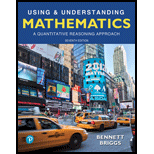
Concept explainers
Get Started Early! Mitch and Bill are both age 75. When Mitch was 25 years old, he began depositing $1000 per year into a savings account. He made deposits for the first 10 years, at which point he was forced to stop making deposits. However, he left his money in the account, where he continued to earn interest for the next 40 years. Bill didn’t start investing until he was 45 years old, but for the next 30 years he made annual deposits of $1000. Assume that both accounts earned an average annual return of 5% (compounded once a year).
a. How much money does Mitch have in his account at age 75?
b. How much money does Bill have in his account at age 75?
c. Compare the amounts of money that Mitch and Bill deposit into their accounts.
d. Write a paragraph summarizing your conclusions about this parable.
Learn your wayIncludes step-by-step video

Chapter 4 Solutions
Pearson eText for Using & Understanding Mathematics: A Quantitative Reasoning Approach -- Instant Access (Pearson+)
Additional Math Textbook Solutions
Basic Business Statistics, Student Value Edition
Elementary Statistics: Picturing the World (7th Edition)
University Calculus: Early Transcendentals (4th Edition)
Elementary Statistics
A Problem Solving Approach To Mathematics For Elementary School Teachers (13th Edition)
College Algebra with Modeling & Visualization (5th Edition)
- Please help with a detailed explaination how to get the answerarrow_forwardMATLAB. Awnser written questions (*) in the comments. Null, Rank, and most functions outside of rref() and disp() are not allowed!arrow_forwardMATLAB. Awnser written questions (*) in the comments. Null, Rank, and most functions outside of rref() and disp() are not allowed! Solutions must be given manually! Elementary form means to reduce to RREF manually, without rref(). Please see other attached image for explanationarrow_forward
- In ΔEFG, e = 520 inches, ∠E=26° and ∠F=107°. Find the area of ΔEFG, to the nearest 10th of an square inch.arrow_forwardIn ΔXYZ, ∠Y=90° and ∠X=25°. ∠ZWY=73° and XW=7.2. Find the length of WY to the nearest 100th. Figure not necessarily drawn to scale. XYWZ25°73°7.2?arrow_forwardIn ΔABC, a = 380 inches, ∠A=72° and ∠B=9°. Find the area of ΔABC, to the nearest 10th of an square inch.arrow_forward


 Intermediate AlgebraAlgebraISBN:9781285195728Author:Jerome E. Kaufmann, Karen L. SchwittersPublisher:Cengage Learning
Intermediate AlgebraAlgebraISBN:9781285195728Author:Jerome E. Kaufmann, Karen L. SchwittersPublisher:Cengage Learning Algebra for College StudentsAlgebraISBN:9781285195780Author:Jerome E. Kaufmann, Karen L. SchwittersPublisher:Cengage Learning
Algebra for College StudentsAlgebraISBN:9781285195780Author:Jerome E. Kaufmann, Karen L. SchwittersPublisher:Cengage Learning Holt Mcdougal Larson Pre-algebra: Student Edition...AlgebraISBN:9780547587776Author:HOLT MCDOUGALPublisher:HOLT MCDOUGAL
Holt Mcdougal Larson Pre-algebra: Student Edition...AlgebraISBN:9780547587776Author:HOLT MCDOUGALPublisher:HOLT MCDOUGAL




